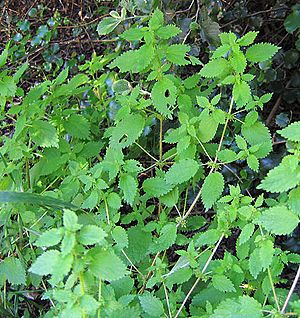Western nettle facts for kids
Quick facts for kids Western nettle |
|
|---|---|
 |
|
| Scientific classification |
Hesperocnide tenella, also known as the western nettle or western stingingnettle, is a small plant found in California and northern Baja California. It's famous for its tiny stinging hairs, much like other nettle plants. This plant grows in dry, shrubby areas and woodlands.
Contents
What is Western Nettle?
The western nettle is an annual plant. This means it grows from a seed, flowers, produces new seeds, and then dies all within one year. Its thin stems stand upright and can grow up to 50 centimeters (about 20 inches) tall.
Why Does it Sting?
Like many other nettle plants, the western nettle has special stinging hairs. These hairs contain a substance called formic acid. If you touch them, they can cause a mild stinging feeling. The plant also has tiny hooked hairs on its flowers.
Leaves and Flowers
The leaves of the western nettle are shaped like an oval. They are somewhat thin and grow in pairs on opposite sides of the stem. The edges of the leaves have many teeth, making them look very jagged.
The plant's flowers grow in round, head-like clusters. Each cluster has two types of flowers:
- Pistillate flowers: These are the female flowers. They have 2 to 4 small leaf-like parts called sepals. These sepals are joined together almost to the top. Each pistillate flower also has one ovary, which will later become the fruit.
- Staminate flowers: These are the male flowers. They have 4 sepals and 4 stamens. Stamens are the parts that produce pollen.
All the flowers are very tiny, only about a millimeter long. After the flowers bloom, they produce small, flat fruits called achenes. These fruits are enclosed by the sepals.
Where Does Western Nettle Grow?
The western nettle is native to specific areas in North America. You can find it growing naturally in California and the northern part of Baja California in Mexico.
It likes to grow in certain types of plant communities:
- Chaparral: This is a type of shrubland with dense, woody shrubs.
- Oak woodland: These are areas with oak trees and other plants.
- Coastal sage scrub: This is a dry, shrubby habitat found near the coast.
This plant can grow at elevations up to about 1,000 meters (around 3,300 feet) above sea level.
Other Types of Hesperocnide
There are only two known species in the Hesperocnide group of plants. One is Hesperocnide tenella, which we've learned about, found in California. The other is Hesperocnide sandwicensis, which is native to Hawaii.

